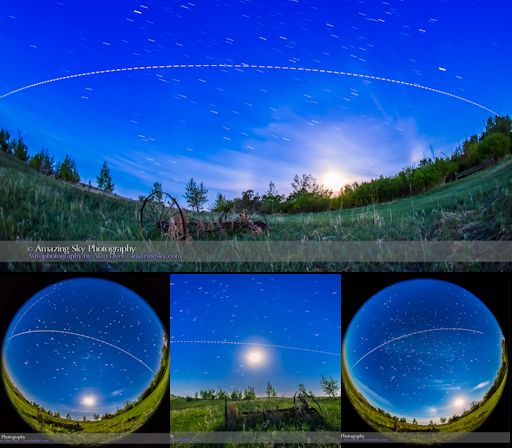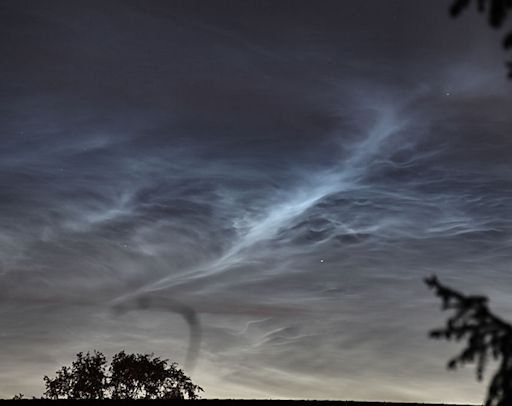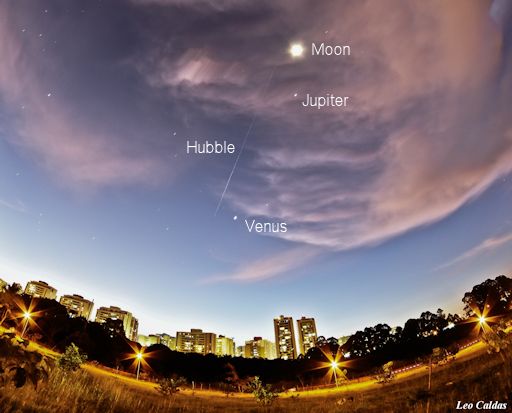Come to Tromsø and share Marianne's passion for rural photography: Chasethelighttours.co.uk invites you to experience "Heaven on Earth" with an aurora, fjord, fishing, whale watching, photography or sightseeing tour. | | |
SPACE WEATHER TEDx TALK: Living on the doorstep of an active star is fraught with peril and beauty. Ryan McGranaghan, a Ph.D. candidate studying space weather at the University of Colorado Boulder, talks about both in a TEDx talk entitled "Living with a Star (and how it will change everything you thought you knew about weather)." Watch it now.
SPACE STATION MARATHON: What's better than seeing the International Space Station glide brightly among the stars on a warm summer night? How about seeing it four times? For the next few weeks, sky watchers in the northern hemisphere can catch the ISS making multiple passes over their home towns. Photographer Alan Dyer sends this report from Gleichen, Alberta: "On the night of May 31/June 1, I was able to shoot the passage of the International Space Station on each of four successive orbits, at 90-minute intervals, from dusk to dawn."

"Seeing the space station on not one but two, three, or even four orbits in one night is possible at this time of year near northern summer solstice because the Station is now continuously lit by sunlight -- the Sun never sets from the altitude of the ISS," explains Dyer. "When the ISS should be entering night, sunlight streaming over the north pole still lights the station at its altitude of 400 km."
Satellite enthusiasts call this an "ISS marathon." Find out when to look using Spaceweather.com's Simple Satellite Tracker.
Realtime Space Weather Photo Gallery
NOCTILUCENT CLOUD SIGHTINGS: We often say that noctilucent clouds are "electric blue." One glance at this photo from Kristianstad, Sweden, explains why:

"On Monday night, pale ripples spread across 90 degrees of the northern sky," says photographer Jonas Carlsson. "This is a great beginning to the 2015 season."
Since June began, sky watchers have seen noctilucent clouds over Ireland, Sweden, Denmark, Scotland and Russia. And more are in the offing.... Data from NASA's AIM spacecraft have shown that noctilucent clouds (NLCs) are like a great geophysical light bulb. They turn on every year in late spring, reaching almost full intensity over a period of no more than 5 to 10 days. News flash: the bulb is glowing, and it is definitely electric blue.
Noctilucent clouds first appeared in the 19th century after the eruption of super-volcano Krakatoa. At the time, people thought NLCs were caused by the eruption, but long after Krakatoa's ash settled, the clouds remained. In recent years, NLCs have intensified and spread with sightings as far south as Utah and Colorado. This could be a sign of increasing greenhouse gases in Earth's atmosphere.
Observing tips: Look west 30 to 60 minutes after sunset when the Sun has dipped 6o to 16o below the horizon. If you see luminous blue-white tendrils spreading across the sky, you may have spotted a noctilucent cloud.
Realtime NLC Photo Gallery
SUNSET SKY SHOW: If you love stargazing, there's a date you should mark on your calendar. It's June. That's right, the whole month. Throughout the month of June 2015, the two brightest planets in the night sky are converging for an amazing sunset sky show. At closest approach on June 30th, Venus and Jupiter will be less than 1/3rd of a degree apart. Even now, a month ahead of time, the gathering is beautiful. Leo Caldas sends this picture from Brasilia, Brazil:

"The Hubble Space Telescope flew by the planets just as I was photographing the conjunction," says Caldas. "Perfect timing."
In the weeks ahead, Venus and Jupiter will draw steadily closer together. You can see the distance shrink every night. Dates of special interest include June 12th, when Venus passes by the Beehive star cluster. Using binoculars, scan the sky around Venus to observe the cluster. On June 19th, the crescent Moon joins Venus and Jupiter to form a bright isosceles triangle in the sunset sky. One night later, on June 20th, the triangle reappears with shape-shifted vertices. From then until the end of the month, the converging planets will rush together, seemingly on a collision course, but actually en route to a near-miss on June 30th-July 1st.
Keep an eye on the sunset sky for the rest of the month. Backyard astronomy alerts: text, voice
Realtime Space Weather Photo Gallery
Realtime Sprite Photo Gallery
Realtime Aurora Photo Gallery
Every night, a network of NASA all-sky cameras scans the skies above the United States for meteoritic fireballs. Automated software maintained by NASA's Meteoroid Environment Office calculates their orbits, velocity, penetration depth in Earth's atmosphere and many other characteristics. Daily results are presented here on Spaceweather.com.
On Jun. 3, 2015, the network reported 13 fireballs.
(13 sporadics)

In this diagram of the inner solar system, all of the fireball orbits intersect at a single point--Earth. The orbits are color-coded by velocity, from slow (red) to fast (blue). [Larger image] [movies]
Potentially Hazardous Asteroids (
PHAs) are space rocks larger than approximately 100m that can come closer to Earth than 0.05 AU. None of the known PHAs is on a collision course with our planet, although astronomers are finding
new ones all the time.
On June 3, 2015 there were potentially hazardous asteroids.
Notes: LD means "Lunar Distance." 1 LD = 384,401 km, the distance between Earth and the Moon. 1 LD also equals 0.00256 AU. MAG is the visual magnitude of the asteroid on the date of closest approach. | | The official U.S. government space weather bureau |
| | The first place to look for information about sundogs, pillars, rainbows and related phenomena. |
| | Researchers call it a "Hubble for the sun." SDO is the most advanced solar observatory ever. |
| | 3D views of the sun from NASA's Solar and Terrestrial Relations Observatory |
| | Realtime and archival images of the Sun from SOHO. |
| | from the NOAA Space Environment Center |
| | the underlying science of space weather |

